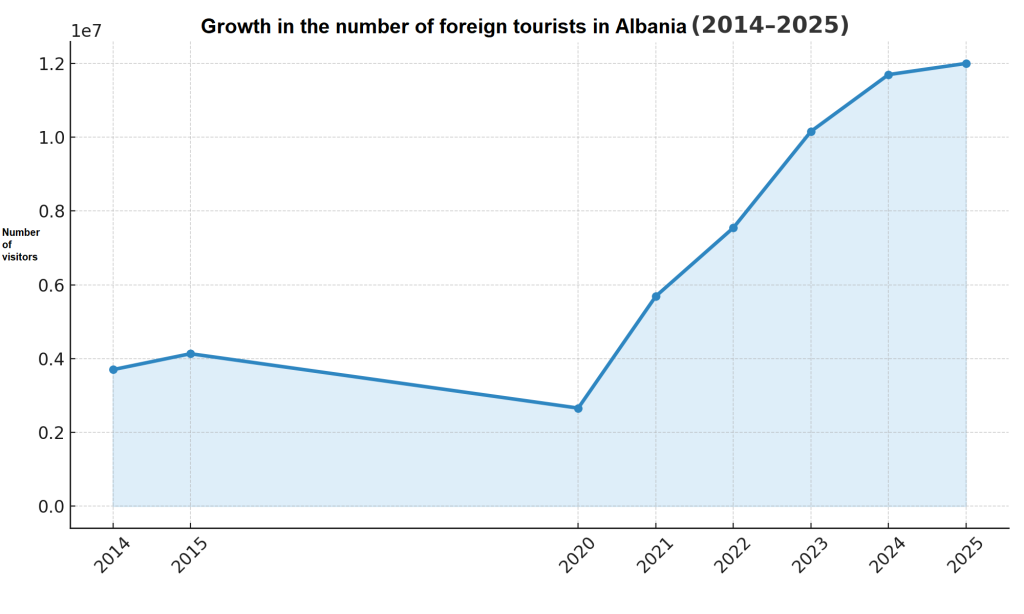In just one decade, Albania has transformed from an almost unknown destination into one of the most exciting spots on Europe’s tourist map. Once isolated and overlooked, it is now breaking visitor records and making headlines in well-known international travel media.
Over the past ten years, Albania has gone from a hidden point on the tourist map to one of the fastest-growing destinations in Europe. The country is experiencing a true tourism boom. This is best shown by data from Albania’s Ministry of Tourism provided to Bankar portal. In 2015, Albania was visited by just over 4.1 million foreign tourists, while in 2024 that number exceeded 11.6 million. The average annual growth rate (CAGR) of foreign tourists in Albania between 2015 and 2024 stands at 12.2% per year.

The country, long isolated and often neglected in travel guides, is now recording steady growth in visitor numbers—thanks partly to its Adriatic and Ionian coastlines, pristine nature, but mostly to affordable prices and improved air connectivity. Albion Idrizi, who has been active in the country’s tourism sector for many years, highlights that the Albanian government took a series of effective steps that led to this expansion.
“Albania experienced a sharp rise in visitor numbers in 2024 due to the remarkable improvement in accessibility and the strong price–value ratio in its tourism offering, including accommodation, facilities, attractions, and activities. In short, all five ‘A’s required for a tourist destination have been met. The government managed to persuade Wizz Air and other low-cost carriers to expand capacity like never before. With nearly 100 destinations and low prices, Albania became accessible to a wider range of people at a cheaper cost. This shows that tourism is highly price-sensitive, and improved accessibility pushes people to consider visiting our country—the last secret of Europe,” says Idrizi.
Recent announcements by low-cost carrier Ryanair about opening a base in Albania suggest that this growth trend will continue in the coming years. Most visitors to Albania come from neighboring countries such as Italy, Kosovo, Montenegro, and Greece, but increasingly also from Western Europe and the United States. According to INSTAT’s 2024 report, the most popular destinations for personal or business travel in Albania are Tirana (15.4%), Vlora (12.3%), Korça (10.9%), and Durrës (8.6%).
The Albanian Riviera, particularly towns like Ksamil, Saranda, and Dhërmi, is now often compared to Greek and Croatian resorts, but with much more affordable prices. International outlets such as Lonely Planet and The Guardian have regularly included Albania on their “must-visit destinations” lists in recent years.
Investments and Challenges
The rising influx of tourists has also spurred infrastructure development. Investments in hotels, roads, and air routes have grown significantly, with new connections linking Tirana and the coast to major European cities. However, challenges remain—lack of a sustainable strategy, pressure on the environment, and tourism seasonality.
“Albania, like Montenegro and other neighboring countries, suffers from poor transport links caused by low GDP and weak investments. But Albania is proof that accessibility is key,” Idrizi notes.
Looking Ahead
The Albanian government has announced a development strategy through 2030, which includes strengthening cultural tourism, promoting mountain and eco-tourism, and stricter coastal protection measures. Their goal, they stress, is for Albania to become not just a summer destination but a year-round one. If the strategy is consistently implemented, tourism experts expect Albania to become a regional leader with strong economic growth over the next decade.

